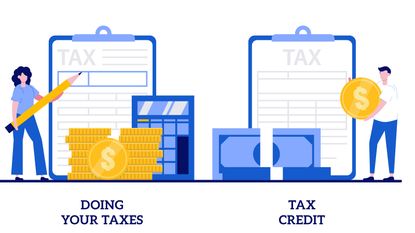13 Tax Breaks for the Middle Class
Middle-class Americans are still feeling a financial squeeze. Fortunately, there are several tax breaks to help those who are struggling financially.

Whether it's dealing with an economic crisis or a health pandemic, middle-income Americans have faced significant financial problems for quite a while now. One reason for this can be attributed to the fact that income for middle-class families continues to rise at a much slower rate than for higher-income Americans.
Thankfully, the number of tax breaks available to low- to middle-income Americans has risen thanks to recent legislation. Many of these tax breaks are temporary, but it's vital for everyone, especially those needing financial assistance, to claim all the tax breaks legally available to them.
Here are 13 tax breaks for middle-income Americans to look at as you plan for and then file your next tax return. Some of these tips can help fatten your wallet and save you money.

Zero Tax on Capital Gains
For most people, long-term capital gains (and qualified dividends) are taxed at 15% or 20%—a bargain by historical standards.
That's why some people get so exercised about a rule that allows hedge-fund managers to pay tax at the capital-gains rate rather than at rates for ordinary income, which top out at 37%.
But investors with lower taxable incomes pay no tax at all on their capital gains and dividends. That could be a boon to retirees, who have a higher standard deduction than younger taxpayers and who aren't taxed on some or all their Social Security benefits, and the unemployed, who may have had to tap their investments to make ends meet.
To take advantage of the 0% capital-gains rate on your 2021 tax return, your taxable income can't exceed $40,400 if you're single; or $80,800 if you're married filing jointly in that year. Note that this is taxable income. That's what's left after you subtract itemized deductions or the standard deduction from your adjusted gross income.

Get Paid (More) for Working
The government provides an incentive for people to work: The Earned Income Tax Credit.
For 2021 tax returns, the maximum EITC ranges from $1,502 to $6,728 depending on your income and how many children you have. This program, originally conceived in the 1970s, has been expanded several times, and some states (and even municipalities) have created their own versions.
Part of what makes it popular: When the federal EITC exceeds the amount of taxes owed, it results in a tax refund—a check back to you. In essence, you're no longer a taxpayer. But you have to act to claim the credit by filing—a step many don't take.
The income limits on this program are fairly low. If you have no kids, for example, your 2021 earned income and adjusted gross income (AGI) must each be less than $21,430 for singles and $27,380 for joint filers. If you have three or more kids and are married, though, your 2021 earned income and AGI can be as high as $57,414. The exceptions are considerable—more complicated than we can list here—but the Center for Budget and Policy Priorities has a handy online calculator to help you determine eligibility.
Similar to last year, EITC rules allow you to use your 2019 income to calculate the credit for the 2021 tax year (instead of your 2021 income). For those who lost their job or saw a significant loss in income in 2021, this can help get the most money out of the EITC.

Breaks for Saving for Retirement
Anyone with earned income (meaning income from work rather than investments) can contribute to a traditional IRA, but not everyone who contributes can claim a tax deduction. That's a no-no for the rich if they're covered by a retirement plan at work.
Here's how the deduction rules operate for traditional IRAs: First, there's a limit on how much you can contribute each year—$6,000 for 2021 ($7,000 if you'll be at least 50 years old by the end of the year) or 100% of your earned income, whichever is less.
If you're not enrolled in a 401(k) or some other workplace retirement plan, you can deduct your IRA deposits no matter how high your income. But if you're enrolled in such a plan, the right to the IRA deduction is phased out as 2021 income rises to $66,000 and $76,000 for singles and between $105,000 and $125,000 for couples. The limits only apply if one spouse participates in an employer plan. If neither does, there are no income limits for taking a deduction.
Spouses with little or no earned income can also make an IRA contribution of up to $6,000 ($7,000 if 50 or older) as long as the other spouse has sufficient earned income to cover both contributions. For 2021, the contribution is tax-deductible as long as income doesn't exceed $198,000 on a joint return. You can take a partial tax deduction if your combined income is between $198,000 and $208,000.

Save and Be Credited
If you're single and have 2021 adjusted gross income of $33,000 or less, or you're married and have AGI of $66,000 or less, you can make out even better on a retirement contribution through the Saver's Tax Credit.
The credit is a potential bonanza for part-time workers who fall within the income limits. You can claim a tax credit worth 10%, 20% or 50% of the first $2,000 ($4,000 for joint filers) you put in—that means a credit of up to $1,000 ($2,000 for joint filers). The lower your income, the higher the percentage you get back via the credit. Contributions to a workplace plan, such as a 401(k) or 403(b), as well as contributions to a traditional, Roth or SEP IRA, are eligible for this credit.
People with disabilities who have an ABLE account can also take advantage of the Saver's Credit. Contributions to these accounts qualify for the credit, so long as they're from the designated beneficiary.
Some key exceptions: Taxpayers under age 18, full-time students and those claimed as dependents on their parents' returns aren't eligible, regardless of their income.
And here's the beauty of a credit compared with a deduction: While deductions reduce the amount of your income that can be taxed, credits reduce the amount of tax you owe—dollar for dollar. You'll need to submit IRS Form 8880.

Your Child, Your Credit
For the 2021 tax year, parents of eligible children under the age of six can claim a $3,600-per-child tax credit. The credit is worth $3,000-per-child for kids between ages six and 17. (The credit is currently scheduled to drop back down to $2,000 for each child 16 years old or younger in 2022 and thereafter.) But unlike past years, the IRS is sending advance payments of the 2021 credit to families each month this year from July to December, although parents can opt-out and receive the full amount when they file their 2021 tax return. For most parents who don't opt-out and receive one or more monthly payments in 2021, the amount they received in advance will be subtracted from the total child tax credit they claim on their 2021 return (some lower-income families won't have to pay back advance payments, though).
As your income rises, the 2021 child tax credit is reduced in two stages. First, the credit is reduced to $2,000-per-child if your income in 2021 exceeds $150,000 on a joint return, $112,500 for head of household filers, or $75,000 for singles. The credit is reduced below $2,000 as income rises above $400,000 on joint returns and above $200,000 on single and head-of-household returns — although there's no limit to how many kids you may claim on a return, if they qualify. (After 2021, only the second reduction will apply.)
The credit is fully refundable for the 2021 tax year. This means that even if you owe no federal income tax, you will still receive the full credit in the form of a tax refund. (After 2021, only up to $1,400 per qualifying child is refundable.)

Get Credit for That Child’s Care
You may also qualify for a tax credit that will reduce the cost of childcare. For the 2021 tax year, if your children are younger than 13, you're eligible for a 20% to 50% credit for up to $8,000 in child-care expenses for one child or $16,000 for two or more. (In 2022, the credit will be worth 20% to 35% of up to $3,000 of expenses for one child or $6,000 for more than one.)
Parents are eligible for the full credit if their AGI doesn't exceed $125,000. The percentage is gradually reduced from 50% to 20% for people with an AGI between $125,001 and $183,000. It stays at 20% for families with an AGI from $183,001 to $400,000, but then it's gradually reduced again from 20% to 0% for taxpayers with an AGI between $400,001 to $438,000. Anyone making over $438,000 won't be eligible for this credit even though they may have been able to claim the credit in past years. (In 2022, the credit will begin to phase out when AGI exceeds $15,000.)
Additionally, due to recent legislative changes, this credit is refundable for the 2021 tax year for people who live in the United States for more than half of the year. This will help lower-income people the most, because they're most likely to lose the credit when it's non-refundable. The credit will go back to being a nonrefundable credit for 2022 and thereafter.
Another way to reduce child-care expenses is to participate in your employer's flexible spending account for dependent-care expenses. With these accounts, money is deducted from your gross salary before income, Social Security and Medicare taxes. For the 2021 tax year, you can contribute up to $5,250 per year for a married person filing separately or $10,500 for individuals or married couples filing jointly. These amounts are higher than usual, but only temporary. So, unless Congress does something soon, the 2021 increase in contributions won't for 2022 and thereafter. Instead, the annual contribution limits will revert back to $2,500 for married people filing separate return and $5,000 for joint filers.

Get Credit for Dependents (When They're No Longer Kids)
If you claim someone other than a child as a dependent (say, an elderly parent or a kid off to college), you can get a $500 tax credit for each of them.
However, the Credit for Other Dependents begins to disappear as income rises above $400,000 on joint returns and above $200,000 on single and head-of-household returns—although there's no limit to how many dependents you may claim on a return, as long as they qualify. Whom can you claim as a dependent? It, well, depends, but the IRS has a helpful tool to guide you through the qualifications.

American Opportunity Credit
This tax credit is available for up to $2,500 of college tuition and related expenses (but not room and board) paid during the year. The full credit is available to individuals whose modified adjusted gross income is $80,000 or less ($160,000 or less for married couples filing a joint return). Single taxpayers with MAGI above $90,000 and married couples with MAGI above $180,000 are ineligible for the credit.
The American Opportunity Credit covers all four years of college. And if the credit exceeds your tax liability (whether derived from the regular income tax or the alternative minimum tax), up to 40% of it is refundable. For example, suppose you owe $1,900 in federal taxes and qualify for the full credit. The nonrefundable portion of the credit will reduce your tax bill to $400, and the first $400 of the refundable portion will lower your bill to zero. You'll receive the remaining $600 as a tax refund.

Lifetime Learning Credit
If you want to get additional education—for virtually any reason and at virtually any school—you can tap the Lifetime Learning Credit. The credit is calculated as 20% of up to $10,000 of qualified expenses, so you can get back as much as $2,000 per year.
For 2021, the income limits for the Lifetime Learning Credit are $90,000 if single and $180,000 if married. Please remember that you can't claim both this credit and the American Opportunity Credit for the same student in the same year. Also, no double dipping allowed: Expenses paid with funds from other tax-favored tuition programs, such as a Coverdell ESA, don't count when figuring either credit.

More Education Breaks for Middles
If neither the American Opportunity Credit nor the Lifetime Learning Credit works for you, there are still other ways the government offers favorable tax treatment for learning—and limits the breaks to the middle class and below.
Got a student loan around your neck? You can deduct up to $2,500 of interest paid on the loan each year, so long as your 2021 modified adjusted gross income (MAGI) is less than $85,000 ($170,000 if filing a joint return). The deduction starts to phase out at a MAGI of $70,000 (for singles) and $140,000 (for joint filers). The former student can deduct this even if it's actually Mom and Dad who are paying the bill.
In addition, interest on savings bonds is usually subject to federal income tax. However, interest on Series EE and I bonds issued after 1989 can be tax-free when used to pay for qualified education expenses, if you meet certain requirements. This benefit phases out gradually as your 2021 MAGI rises between $124,800 and $154,800 for joint filers and from $83,200 to $98,000 for singles. Important note: If you're using savings bonds to pay for a child's education, the bonds must be in your name to qualify for the exclusion. Savings bonds in the child's name aren't eligible.

Charitable Deduction for Non-Itemizers
For 2021 only, there's an "above-the-line" deduction for up to $300 for cash donations to charity ($600 for those married and filing jointly). Donations to donor advised funds and certain organizations that support charities don't qualify for this tax break.
Normally, you must itemize on Schedule A to get a deduction for charitable donations. In this case, though, it's the other way around—if you itemize, you can't take this new deduction. Generally, most people who itemize have higher incomes. So, this tax break is for middle- and lower-income Americans who claim the standard deduction, instead.

Adoption Credits
A person who adopts a child can take a tax credit to help cover expenses related to the adoption. Out-of-pocket expenses can be significant with adoptions, including attorney fees, court fees and travel costs. For 2021, the adoption credit can be taken on up to $14,440 of qualified expenses per child (the 2022 amount is not yet available). This means that if someone has just $5,000 in qualifying expenses in 2021, they won't be eligible for the full $14,440 credit. However, those who adopt children with special needs can take the full credit even if their expenses are less. In addition, families with AGIs over $216,660 will have the credit lowered and those with AGI's over $256,660 will have the credit completely phased out.
Although this credit is nonrefundable, any surplus credit can be carried forward for up to five years. Additionally, there are some restrictions on those being adopted. The person who is being adopted must be a child 17 years old or younger or a person of any age who is physically or mentally incapable of caring for themselves. But you can still take the credit if the specific child being adopted has not been picked out yet (e.g., for the cost of a home study conducted at the beginning of the adoption process).

Premium Tax Credit
Paying the premiums for your health insurance purchased through an Obamacare exchange can be pricey. The premium tax credit helps people cover those premiums. Normally, your household income must be between 100% and 400% of the federal poverty level, and people with a lower income get a larger credit. However, the American Rescue Plan boosted the credit for 2021 and 2022. The credit amount for eligible taxpayers was increased by reducing the percentage of annual income that households are required to contribute toward their premium, and people with household income above 400% of the federal poverty line are eligible for the credit. Additionally, those who received unemployment benefits will see a bump in premium tax credits for 2021.
In addition, if someone purchases insurance through an exchange, they can choose to have an estimated credit amount paid in advance to their insurance company so that less money comes out of their own pocket to pay monthly premiums. When they submit their tax return, the calculated credit will be compared to any advance payments. If the advance payments are greater than the allowable credit, the difference normally must be paid back either by subtracting the difference from a tax refund or adding it to the tax owed. However, for the 2020 tax year, advance payments that exceeded the credit amount on your tax return didn't have to be repaid. For the 2021 tax year and beyond, they will need to be repaid again, though.
Get Kiplinger Today newsletter — free
Profit and prosper with the best of Kiplinger's advice on investing, taxes, retirement, personal finance and much more. Delivered daily. Enter your email in the box and click Sign Me Up.

Block joined Kiplinger in June 2012 from USA Today, where she was a reporter and personal finance columnist for more than 15 years. Prior to that, she worked for the Akron Beacon-Journal and Dow Jones Newswires. In 1993, she was a Knight-Bagehot fellow in economics and business journalism at the Columbia University Graduate School of Journalism. She has a BA in communications from Bethany College in Bethany, W.Va.
-
 Stock Market Today: Dow Rises 854 Points From Its Intraday Low
Stock Market Today: Dow Rises 854 Points From Its Intraday LowIf there's one thing markets hate, it's uncertainty. But uncertainty is all they're getting these days.
By David Dittman Published
-
 Are You a Retirement Millionaire Too Scared To Spend?
Are You a Retirement Millionaire Too Scared To Spend?If you are too scared to spend money in retirement, you may be saddled with regret. Here are three ways to safely enjoy your sizable retirement nest egg.
By Donna Fuscaldo Published
-
 Tax-Deductible Home Improvements for Retirement in 2025
Tax-Deductible Home Improvements for Retirement in 2025Retirement Taxes Your aging-in-place plan could benefit from the medical expense tax deduction. But watch out for capital gains and property taxes.
By Kate Schubel Published
-
 What Does Medicare Not Cover? Eight Things You Should Know
What Does Medicare Not Cover? Eight Things You Should KnowHealthy Living on a Budget Medicare Part A and Part B leave gaps in your healthcare coverage. But Medicare Advantage has problems, too.
By Donna LeValley Published
-
 New Colorado Tax Credit: What’s the Scoop?
New Colorado Tax Credit: What’s the Scoop?State Tax Everything you need to know about the Colorado family affordability tax credit in 2025.
By Kate Schubel Published
-
 Key Family Tax Breaks Are on the GOP Chopping Block This Year
Key Family Tax Breaks Are on the GOP Chopping Block This YearTax Credits Several tax breaks, including the Child Tax Credit, may face reforms or be cut entirely as lawmakers seek revenue for Trump’s tax plans.
By Gabriella Cruz-Martínez Last updated
-
 What's Going on With New Jersey Property Tax Programs?
What's Going on With New Jersey Property Tax Programs?Property Tax ANCHOR and ‘Senior Freeze’ just got a refresh, and there’s a new program: Stay NJ. Learn how to save on New Jersey property taxes.
By Kate Schubel Published
-
 Five States With the Largest EITC Checks
Five States With the Largest EITC ChecksEITC Households in these states received a larger Earned Income Tax Credit (EITC) last year.
By Gabriella Cruz-Martínez Published
-
 Downsize in Retirement With 2025 Tax Benefits: Three Key Strategies
Downsize in Retirement With 2025 Tax Benefits: Three Key StrategiesRetirement Taxes Downsizing retirees may benefit from tax savings, lower utility bills, and freed-up income. But could a new presidency impact your home sale?
By Kate Schubel Published
-
 15 Reasons You'll Regret an RV in Retirement
15 Reasons You'll Regret an RV in RetirementMaking Your Money Last Here's why you might regret an RV in retirement. RV-savvy retirees talk about the downsides of spending retirement in a motorhome, travel trailer, fifth wheel or other recreational vehicle.
By Bob Niedt Published



